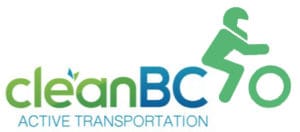Active Transportation is British Columbia’s initiative for cleaner and more “active” transportation. It’s part of the Province’s “CleanBC” plan.
CleanBC identifies initiatives and priorities to help grow a low-carbon economy that creates opportunities for all British Columbians while protecting the air, land and water. When it comes to transportation, that means:
 1. Providing cleaner options.
1. Providing cleaner options.
2. Helping to reduce gridlock.
3. Reducing carbon pollution.
CleanBC argues for building a sustainable transportation system – one that may persuade people out of their cars and that is accessible for everyone. By making it easier for people to commute to work or school using active transportation methods, we cut down on carbon pollution and help make life better for people.
There is a strong case to be made for the powered two-wheel community having been shortchanged as an obvious form of Active Transportation and an obvious partner in the Active Transportation strategies and programs.
1. Motorcycles and scooters get people out of cars. They can be very affordable.
2. Generally, they produce much less GHG emissions than cars. (Plus, new electric models are dramatically changing the landscape.)
3. Reducing traffic gridlock with motorcycles and scooters has been proven on a global scale.
4. Motorcycles and scooters take over for longer commutes, whereas bicycles are unrealistic.
5. Motorcycles and scooters use much less space than cars and are less worn on roadways.
6. Motorcycles and scooters pay a number of provincial taxes, which fund government programs.
There is an “active science” part of motorcycles and scooters as well.
When you ride a motorcycle, you use lots of different muscles to keep the bike upright and generate the right turning forces through corners and bends. The fitter you are, the longer it will take for you to become distracted when active, and a distracted rider is one who’s heading for a fall.
Riding a motorcycle is always an engaged, visceral experience. (That’s how you survive.) Naturally, the degree of physical benefit is indexed to the type and size of your ride, as well as how often you ride, but the basics apply to everyone. There is even research to show the extra concentration needed to successfully operate a motorcycle contributes to higher general levels of brain function.
Wait, there’s more.
“Vision Zero“ and RoadSafetyBC merit inclusion in this discussion. The BC government’s RoadSafetyBC is a partner in Active Transportation programming and they like the “Vision Zero” thinking. In 2017, Canadian cities began to implement Vision Zero, a five-year plan aimed to reduce traffic-related fatalities and serious injuries. It’s modelled on a Swedish initiative, developed in the late 1990s that had four pillars: ethics, responsibility, a philosophy of safety, and creating mechanisms for change.
The short version of Vision Zero thinking is system designers and enforcers—such as those providing the road infrastructure, the car-making industry and the police—are responsible for the functioning of the system. At the same time, the road user is responsible for following basic rules such as obeying speed limits and not driving while under the influence of alcohol, or otherwise impaired.
Motorcycle stakeholders have been in lockstep with “responsible user” thinking and their ongoing awareness campaigns. Globally, the riding community message is emphasizing riding sober, slowing down, and distracted drivers. These are key points of the Vision Zero messaging as well. In addition, the motorcycle-making industry is introducing ever increasing levels of safety technology in their products.
Let’s end with government policy makers go-to development move; find another jurisdiction doing it right.
One of the thought leaders is the UK’s Motorcycle Industry Association. Their “The Route to Tomorrow’s Journeys” examines the current situation and delivers a series of rational, workable solutions to demonstrate the pivotal role the “Powered Light Vehicles” (PLVs), including motorcycles and scooters, could and should play.
Check out their Low Carbon Partnership part of the program. PLVs fit seamlessly into the transport mix, complementing walking, cycling and public transport and coming into their own where those options are not viable.
In summary, let’s think bigger, be more inclusive. Active Transportation advocates are key. Powered two-wheelers want a safer transportation system every bit as much as you. Support them as you would all vulnerable road users. It’s essential to include motorcycles and scooters in planning and safety messaging. Globally, they are seen as part of the solution. It should be that way in Canada.
There could even be another version of the CleanBC logo:

Just saying.
Paul McGeachie is MCC’s treasurer and a powered two-wheel and powersport marketing and policy specialist.
